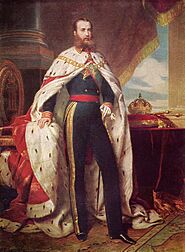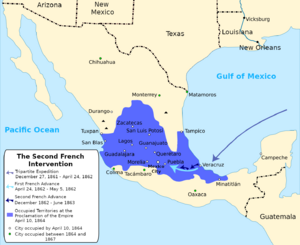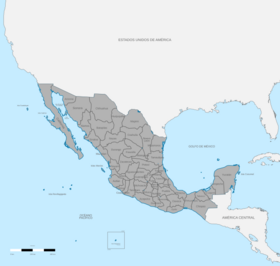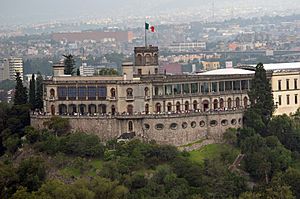Second Mexican Empire facts for kids
The Second Mexican Empire (also known as the Mexican Empire) was a time in Mexico's history when it was ruled by an emperor instead of a president. This happened because some Mexican groups who wanted a king, along with help from France, decided to set up a monarchy.
Quick facts for kids
Mexican Empire
Imperio Mexicano (Spanish)
|
|||||||||
|---|---|---|---|---|---|---|---|---|---|
| 1863–1867 | |||||||||
|
|
|||||||||
|
Motto: Equidad en la Justicia
"Equity in Justice" |
|||||||||

Territory administered (light green) and territory claimed (dark green) by the Second Mexican Empire on April, 1864 when Maximilian accepted the throne.
|
|||||||||
| Status | Independent monarchy, client state of France | ||||||||
| Capital | Mexico City | ||||||||
| Common languages | Spanish | ||||||||
| Government | Federal parliamentary constitutional monarchy | ||||||||
| Emperor | |||||||||
|
• 1864–1867
|
Maximilian I | ||||||||
| Regency | |||||||||
|
• 1863–1864
|
Juan Almonte, José Salas, Pelagio de Labastida | ||||||||
| Prime Minister | |||||||||
|
• 1864–1866
|
José María Lacunza | ||||||||
|
• 1866–1867
|
Teodosio Lares | ||||||||
|
• 1867
|
Santiago Vidaurri | ||||||||
| Historical era | New Imperialism | ||||||||
| 8 December 1861 | |||||||||
|
• Maximilian I accepts Mexican crown
|
10 April 1863 | ||||||||
|
• Emperor Maximilian I executed
|
19 June 1867 | ||||||||
| Currency | Peso | ||||||||
| ISO 3166 code | MX | ||||||||
|
|||||||||
| Today part of | Mexico | ||||||||
The French Emperor Napoleon III wanted to create a friendly country in the Americas. He hoped this new monarchy would help stop the growing power of the United States. So, he supported Mexican conservatives, who wanted a king. They invited an Austrian Archduke named Maximilian to become the Emperor of Mexico. Maximilian was related to old rulers of Mexico. His wife was the Belgian princess Charlotte, known in Mexico as "Carlota."
The French army took control of central Mexico. But supporters of the Mexican Republic, led by President Benito Juárez, kept fighting. Even though Juárez had to leave the capital, Mexico City, he never left Mexico. Maximilian's government was recognized by many European countries, but not by the United States. The U.S. was busy with its own Civil War (1861–1865). After the U.S. Civil War ended in 1865, the U.S. pressured France to leave Mexico.
In 1866, Napoleon III started pulling his troops out of Mexico. These French troops had been supporting Maximilian's rule. Maximilian had also upset his conservative supporters because he had some liberal ideas. He tried to make some changes, but his reign was short. Even though his situation looked hopeless, Emperor Maximilian refused to leave. Republican forces captured him and his two main generals in Querétaro. The Empire ended on June 19, 1867, when Maximilian was executed by a firing squad. The Mexican Republic was then fully restored.
Contents
History of the Empire
After Mexico became independent, it was briefly a monarchy for about a year. Then, it became a republic in 1824. But some people still liked the idea of a monarchy. In 1861, Mexican conservatives and Emperor Napoleon III of France made a plan. They agreed to create a new monarchy in Mexico. Archduke Maximilian agreed to be emperor with France's military and money. The French army removed Mexican President Benito Juárez from the capital. Maximilian and Carlota arrived in Mexico in 1864. The Empire lasted only as long as France supported it. It quickly fell apart when Napoleon III took his help away.
Why Mexico Wanted a Monarchy
After Mexico's war for independence (1810–1821), it became independent under Agustín de Iturbide. He united different groups and planned for Mexico to be a monarchy. He even invited a Spanish royal to be king. When that didn't work, Mexico's congress chose Iturbide himself to be the first Mexican emperor. His rule lasted less than two years. The idea of a monarchy seemed bad for a while. But many problems continued in Mexico, so some people still thought a king might bring order.
French people started showing interest in a Mexican monarchy as early as 1830. Some Mexican thinkers also wrote essays supporting the idea of a European king ruling Mexico. French diplomats often agreed with Mexican conservatives. They thought a monarchy might be better for Mexico at that time.
In the 1850s, under President Santa Anna, Mexican officials tried to find a European candidate for the throne. Even after Santa Anna's government fell, some people kept trying to bring a king to Mexico.
French Invasion and the New Monarchy
The situation changed, making a French invasion and a monarchy in Mexico possible. Mexican conservatives got the attention of French Emperor Napoleon III. He liked the idea of bringing back a Mexican monarchy and having France be powerful in the Americas again. Before 1861, the U.S. would have stopped any European interference in Mexico, because of something called the Monroe Doctrine. But in 1861, the U.S. was fighting its own American Civil War. This meant the U.S. government couldn't directly stop France. However, the U.S. never approved of the French invasion.
In July 1861, Mexican President Benito Juárez said Mexico would not pay its debts for two years. France and other countries were owed money. Napoleon III used this as an excuse to send his army. He was also encouraged by his wife, Empress Eugenie, who wanted to help the Catholic Church in Mexico. Napoleon III saw a chance to make France a big influence in the Western Hemisphere and get access to markets in South America.
French troops arrived in December 1861. They were joined by Mexican conservative generals. The French were stopped at the Battle of Puebla on May 5, 1862. But more French soldiers arrived, and they finally took Mexico City in June 1863. The French then wanted to set up a Mexican government they could control. They chose a group of Mexicans who decided to invite Archduke Maximilian to be Emperor of Mexico. Maximilian agreed on April 10, 1864, and sailed to Mexico. He arrived in Veracruz on May 28 and reached the capital on June 12.
Even though French troops controlled the main cities, President Juárez stayed in Mexico. He moved north towards the border. In the countryside, Mexican fighters (called guerrillas) kept fighting against the French and their Mexican allies.
Maximilian's Time as Emperor
Maximilian and Carlota were crowned in Mexico City. When he arrived, Maximilian offered forgiveness to all liberals who would join his Empire. He managed to get some moderate liberals to support him. His first goals were to improve his government and the Mexican army.
Maximilian soon upset the conservative people who had helped him become emperor. In December, a representative from the Pope arrived to discuss the laws about the Catholic Church. The previous liberal government had taken away some Church property. Maximilian, even though he was Catholic, had liberal ideas. He decided to keep the liberal laws about freedom of religion and Church property. This made the Catholic leaders and many conservatives angry. Maximilian even sent some Mexican generals out of the country and broke up the small Mexican army that supported the Empire.
Maximilian took trips around the country while Empress Carlota ruled as regent (a temporary ruler). He visited different states, met people, and even celebrated Mexican independence.
The Empire's Military Problems
French troops had taken a lot of Mexican land while the U.S. was fighting its Civil War. But in April 1865, the Union won the U.S. Civil War. The U.S. government didn't want to fight France directly, but it supported Mexican President Benito Juárez. The U.S. government refused to recognize Maximilian's Empire. In December 1865, a large loan was approved for Juárez, showing that the U.S. believed he would return to power. American volunteers also joined the Mexican republican troops. The U.S. put diplomatic pressure on France to leave Mexico.
As French troops focused on the north, republican fighters in the south became more active. Even though French troops controlled cities, the guerrillas were a big threat in the countryside. In October, Maximilian signed a harsh order called the "Black Decree." It said that anyone helping or fighting with the guerrillas would be executed. This made the Empire very unpopular.
In January 1866, Napoleon III realized the war couldn't be won. He announced that he would pull French soldiers out of Mexico. The U.S. was now free to enforce the Monroe Doctrine. Maximilian asked France for more help, but Napoleon III refused. Empress Carlota went to Europe to ask for support, but she couldn't get France to change its mind.
Changes in Government Policy
By July 1866, the government started to become more conservative. This was because Maximilian's advisors noticed that many Mexican people, especially indigenous communities, preferred older ways of life. They wanted their traditional rights and lands back, which had been taken away by liberal laws. The government began to move away from liberal ideas.
Laws were passed that gave legal rights back to indigenous communities. They also recognized their right to own land together, like they did in the past. This was different from the liberal idea of only individual land ownership. Maximilian also tried to protect poor people and workers. He was influenced by ideas that valued small farms over large estates.
The Empire Falls
As France pulled its soldiers out, Maximilian's empire began to collapse. In October 1866, Maximilian moved his government closer to the coast. People thought he was going to leave Mexico. He thought about giving up his throne, but his ministers voted against it. He wanted to ask the Mexican people to decide what kind of government they wanted. But President Juárez would never agree to a ceasefire with the emperor.
After this plan failed, Maximilian focused on fighting. In February 1867, the last French troops left Mexico. Maximilian went to Querétaro, north of the capital, to join his Mexican soldiers. Republican generals surrounded Querétaro with a much larger army. The city was captured on May 15, 1867, after an imperial officer betrayed them.
Maximilian was captured and put on trial with his generals Mejía and Miramón. All three were found guilty and executed by the republican army on June 19, 1867.
How the Government Worked
A temporary set of rules was made in 1865, which explained how the government would work. The emperor would rule through nine government departments. These departments formed a Council of Ministers, which discussed issues the emperor brought to them. The emperor chose the head of the Imperial Household and the Minister of State. The Minister of State then chose the other ministers.
A Council of State helped create laws and advised the emperor. Empress Carlota was allowed to be a regent if Maximilian was unavailable. This made her the first woman to govern Mexico.
Maximilian had many plans for Mexico, even though his rule was short. In 1865, his government planned to divide Mexico into new regions. They also made many laws about things like forests, railroads, roads, postal services, mining, and immigration.
The emperor passed laws that said everyone was equal before the law and had freedom of speech. He also tried to protect workers' rights, especially for indigenous people. Maximilian tried to pass a law that would give native people a fair wage and stop physical punishment. He also wanted to limit how much debt they could inherit. These ideas faced some resistance but were eventually passed. A national system of free schools was also planned. Maximilian also created the Imperial Order of the Mexican Eagle as a special award for people who did great things for the empire.
Maximilian wanted to help Mexico grow by encouraging people from other countries to move there. He set up an agency to bring immigrants from the United States, Europe, and Asia. New settlers would become citizens right away. They would also be free from taxes for the first year and from military service for five years.
Helping Indigenous Communities
Many indigenous communities supported the Empire. This was because the previous liberal laws had taken away their communal lands. For liberals at the time, land ownership meant owning land as an individual. They saw communal ownership as old-fashioned. A law from 1856 that took away community lands was seen by many indigenous people as a "declaration of war" against them. They felt it threatened their traditional way of life.
So, many indigenous groups joined the imperial cause. They hoped the Empire would help them get their ancestral lands back. For example, the Pames and Otomíes joined General Tomás Mejía. The Purépechas joined General Juan Nepomuceno Almonte. Many indigenous people served the Empire as guides, counter-guerrillas, and volunteers in the Imperial Army.
The emperors Maximilian and Carlota also stopped the practice of "levy," where republican armies would force indigenous men to join their ranks. The French and Austrian soldiers generally paid for what they took, unlike the republican armies.
Maximilian even tried to learn Nahuatl, an Aztec language. Laws were published in both Spanish and Nahuatl. He also appointed a Nahuatl expert as an advisor. The Empire also focused on Mexican history and culture. Maximilian asked Mexican painters to create art showing Mexican history and rulers. He also told officials to protect old artifacts. He even asked Europe to return native artifacts taken during the Spanish conquest.
On June 6 and September 15, 1865, Maximilian made laws that gave legal rights back to indigenous communities. These laws recognized their right to collectively own their ancestral lands. This is why many indigenous people volunteered for his army, even though forced recruitment was forbidden.
Religious Policy
At first, there were disagreements between Maximilian and the Catholic Church. A representative from the Pope arrived in December 1864. He asked Maximilian to bring back the Catholic Church's power and property. He also wanted Catholicism to be the only religion allowed in Mexico.
Maximilian, however, offered a different plan. He said the Mexican government would allow all religions, but would especially protect Catholicism. He also wanted the government to pay Catholic priests, like other public officials. He wanted the Church to give its income from property to the government.
Maximilian had to be tolerant of different religions because his army included Muslims, Orthodox Christians, and Protestants. Empress Carlota also wanted to encourage people from all over the world to move to Mexico, which would require religious tolerance.
Despite these differences, Empress Carlota believed the Empire had a religious purpose. She saw Maximilian, a descendant of Charles V, ruling Mexico as a way to make up for past wrongs.
Later, as the Empire faced defeat, Maximilian became more open to the Church's demands. In 1866, a new agreement was proposed that would give the Church more power and return its properties. This was an attempt to regain support from Mexican conservatives, who were the only ones left to defend the Empire after the French left.
Social Policies
Maximilian's government also made laws to help the poor. They ended hereditary debts, which meant children didn't have to pay their parents' debts. They banned child labor and physical punishment. Employers had to give workers one day off a week and provide schools for their employees' children. The workday was set at eight hours.
A special board was created to help the "needy classes." This board made laws about farm work and land ownership disputes. It protected the communal lands of indigenous people and helped those who didn't own land get it. These laws aimed to improve the lives of indigenous people, farmers, and workers. Maximilian was very concerned about the poor conditions he saw and wanted to help them.
He also worked to end slavery. He declared that any Black person who came to Mexico would be free. This was important for Confederate migrants from the southern United States who wanted to settle in Mexico.
Economy and Development
Railways
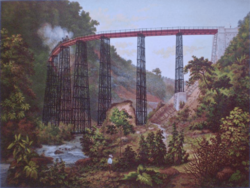
One big challenge for the Emperor was that Mexico didn't have enough roads or railways to connect its different parts. A main goal was to build a railway from the port of Veracruz to Mexico City. Work on this railway started in 1864 under Emperor Maximilian. However, political problems kept slowing it down. The first part of the railway from Veracruz to Mexico City was finally opened nine years later, in 1873, after the Empire had fallen.
During the French invasion, some parts of the railways were destroyed. The French Army helped fund the rebuilding and extension of the lines. By the end of the Empire in June 1867, 76 kilometers of track were working from Veracruz, and the line from Mexico City reached Apizaco, covering 139 kilometers.
Banking

Before 1864, Mexico didn't have a banking system. Religious groups sometimes lent money to wealthy people. During the French rule, a branch of a British bank, The London Bank of Mexico and South America Ltd., opened in Mexico City.
Foreign Trade
At the start of the American Civil War, the city of Matamoros was a small town near the U.S. border. But because it was close to Texas, it became a very busy port. Before the war, only a few ships came to the port each year. Within about four years, Matamoros became very active, and its population grew a lot.
The trade of cotton brought many people to Matamoros and a nearby town called Bagdad. These people were from the Union and the Confederacy (during the U.S. Civil War), England, France, and Germany. Bagdad grew into a full town. By 1864, so many English-speaking people were in the area that Matamoros even had a newspaper in English. The port exported cotton to England and France, where millions of people needed it.
After the U.S. Civil War ended, the port of Bagdad faced a severe crisis and never fully recovered. A huge hurricane in 1889 also destroyed the port and caused Matamoros's population to drop by almost half.
Dividing the Land
Maximilian I wanted to divide Mexico's land in a new, scientific way. He didn't want to follow old historical borders. He asked Manuel Orozco y Berra to design this new division.
The plan was to divide Mexico into at least 50 departments. They tried to use natural borders like rivers or mountains. They also considered the land, climate, and what could be produced there. The goal was for each department to eventually have about the same number of people.
On March 13, 1865, the new law on how Mexico's land would be divided was published. The Empire was split into 50 departments. However, because of the ongoing war, not all of these departments could actually be governed.
Legacy of the Empire
Even though the Empire lasted only a few years, some of Maximilian's building projects are still important landmarks in Mexico City today.
For his home, Maximilian decided to fix up an old villa in Mexico City. This villa was also famous for being the site of a battle during the U.S. invasion of Mexico. It became Chapultepec Castle, the only castle in North America ever used by a monarch. After the Empire fell, Chapultepec Castle was used by Mexican presidents until 1940, when it became a museum.
To connect the palace to government offices in Mexico City, Maximilian also built a grand road. He called it Paseo de la Emperatriz (The Empress' Promenade). After the Empire fell, the government renamed it Paseo de la Reforma (Promenade of the Reform) to remember the liberal reforms. Today, it is still one of the most important avenues in the capital, with many monuments along it.
The bolillo, a type of bread common in Mexican cuisine, was brought to Mexico by Maximilian's cooks. It is another lasting legacy of the Imperial Era.
Today, small groups like the Nationalist Front of Mexico still support the idea of the Second Mexican Empire. They believe the Empire was a good attempt to free Mexico from the influence of the United States. They gather every year at Querétaro, where Maximilian and his generals were executed.
Images for kids
-
A delegation of the Kickapoo people being received at the royal court.





